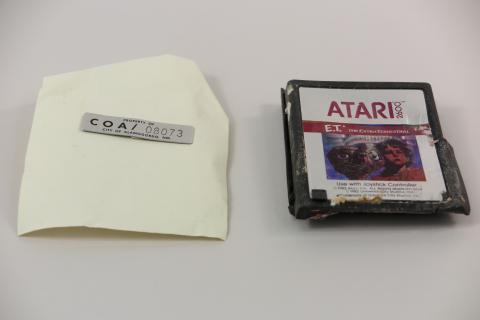The title that almost single-handedly ended console gaming before it truly began will soon take its place next to several hallowed video game relics in the Smithsonian Institution’s National Museum of American History.
According to a Smithsonian blog post, a battered copy of the Atari 2600 game E.T. The Extra-Terrestrial will join Atari founder Nolan Bushnell’s Pong arcade cabinet and recently deceased Ralph Baer’s prototype for the first console in the museum’s video game history collection. The cartridge was one of thousands of Atari 2600 games unearthed earlier this year from a landfill in Alamogordo, New Mexico.
Museum technician Drew Robarge said in the blog that the once-buried game “personifies the video game crash that took place from 1982-1985.” He did not specify exactly when the game will go on display.
Robarge lobbied Fuel Entertainment, which filmed the excavation as part of a documentary for Xbox, for a cartridge, and the company sent him one along with a certificate of authenticity. Fuel Entertainment joined forces with the City of Alamogordo and the Tularosa Basin Historical Society to orchestrate the excavation in April.
Atari rushed the development of E.T. in order to hit shelves by Christmas of 1982 and capitalize on the film of the same name’s blockbuster success. The result is widely considered one of the worst games ever released, as well as one of the largest commercial failures — it sold roughly 25 percent of the four million copies needed just to break even — in the gaming industry.
The E.T. release helped trigger the crash, which plunged the American video game industry into a sea of bankruptcy and mistrust for three years. In 1985, the industry rebounded with the emergence of Nintendo.
This saga serves as a cautionary tale to modern developers. They release more and more movie-branded titles on traditional consoles as film companies crank out gamer-friendly blockbusters like The Lord of the Rings and Spider-Man. Modern browser, flash, and mobile platforms have spawned hundreds of film-based titles over the last decade.
The failure also serves as a reminder for the corporate bigwigs in gaming not to cut corners. Robarge points out that Atari gave E.T. developer Howard Scott Warshaw only five and a half weeks – at a time when six to nine months was customary – to create the game.
Some of the unearthed Atari 2600 games are proving to be quite the commodity, as The City of Alamogordo made $37,000 as of November off the sale of just 100 cartridges.
It’s a good thing Robarge acted quickly to grab a piece of the video game industry’s dirty laundry.
VentureBeat's mission is to be a digital town square for technical decision-makers to gain knowledge about transformative enterprise technology and transact. Learn More

